Fancy Pigeon Breeds that Thrive in Diverse Habitats
The history of fancy pigeon breeds spans centuries and is closely linked to human civilization. You can find that these pigeons all have magnificent appearances and can adapt well to different habitats.
So, what are those fancy pigeon breeds that thrive in diverse habitats? Generally, croppers, frills and groups of sporting, homing, color and voice pigeons fall into these adaptive breed groups.
Several of the most common breeds of fancy pigeons are Trumpeters, Fantails, Jacobins, Swallows, Tripplers, Rollers, Ice pigeons, etc.
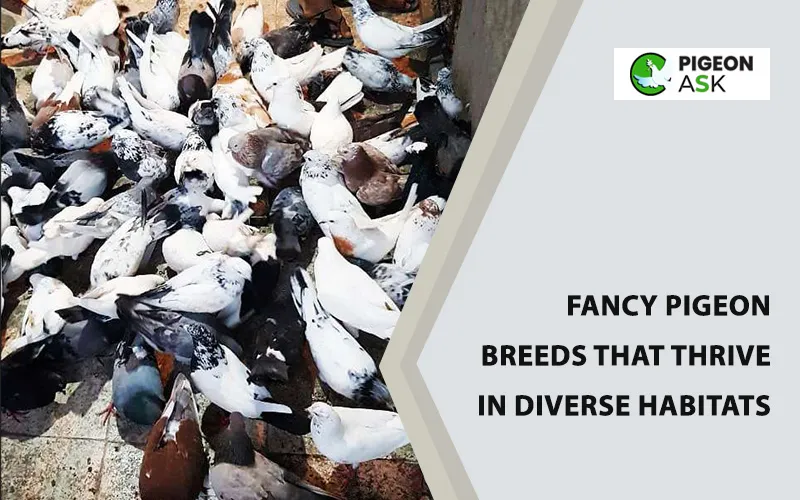
In this article, we will discuss their history, selection, adaptability and care in different habitats. You will also learn about their nutritional requirements. Hence, keep reading.
Different Types of Fancy Pigeon Breeds
The information available in books, reports and articles indicates that there are 116 fancy pigeons worldwide. They encompass a wide variety of physiques, colors, sizes, shapes and patterns.
Depending on that, you can divide them into several groups. Here, we are providing several common types of their breeds –
01. Voice pigeons
Also called Asian feather pigeons, you can recognize this breed by their pleasant, cooing voice. Their extensive feathers and Asian origin are the reasons for this name.

The most common pigeons that fall under this type are as follows.
#Jacobin
Pigeons of this breed can be white, red, blue, black, silver and yellow. This medium-sized species has a russet-shaped cowl on its head.
If you want to breed them in captivity, you need to trim their hood as it interferes with mating. Also, their male members are quite aggressive.
#Fantail
Their fan-shaped tail gives them a magnificent appearance. There will be thirty to forty 12″ feathers in their tail. They are not aggressive but rather quite friendly. You will find them exploring their surroundings calmly.
#Trumpeter
Pigeons of this breed have large and feathered feet. Their voice will sound like low laughter to you.
Also, they are quite friendly and calm. You can teach them simple tricks.
02. Cropper
This breed can inflate its crop, which makes it look more beautiful. They are mainly distributed in different countries in Europe. The common pigeons in this group are as follows.
#Holle Cropper
They have S-shaped necks and compact horizontal tails. Generally, they love it when you give them attention.
#Norwich Cropper
They can hold their crops inflated for a prolonged time. You may think they will attack you. But, they are quite calm and friendly species. Though they can fly, fanciers mostly use them in exhibitions.
#Old German Cropper
You can say that they are the longest breed of pigeons. Their wings are so long that the wings can exceed even their tails.
03. Frills
Also reversed. The groups of frill pigeons are found in Europe and some parts of Northern America. Some examples of this group are as follows.
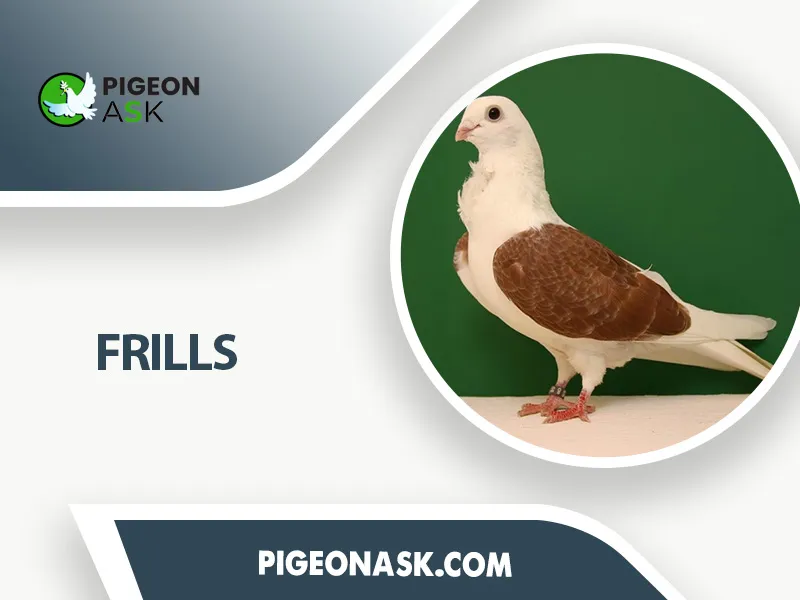
#Turbit
These pigeons mostly have white bodies with different colors in their wings. Their beaks are small and they also walk straight.
As they are very social, you should avoid keeping them in isolation.
#Oriental Frill
It’s a Turkish breed of pigeon with a short beak. You will also notice a crest-type area on their head.
Thanks to their temperature tolerance, you can keep them both in outdoor or indoor environments.
#Chinese Owls
Pigeons of this breed are slow maturing. They need specialized care during their breeding. Also, they have short beaks, round heads and distinctive crests.
04. Color Family
The specialty of this group is their distinctive color. As their origin is Germany, you can also term them as German toys. Examples include the following.
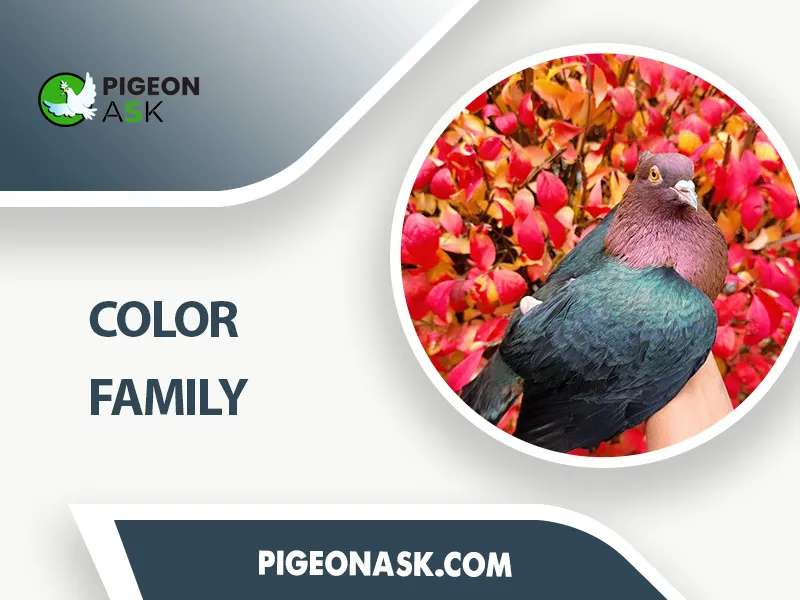
#Swallow
You will find distinctive patterns and markings in their body.
#Archangel
They have gold or bronze bodies with blue, white, or black colored wings. Their legs will be unfeathered and their eyes will be orange.
#Ice Pigeons
Their ice-blue color comes from the light reflected from the dust of their feathers. Plus, their feet can have feathers as well.
05. Sporting Pigeons
Pigeons of this group have magnificent sporting ability. They can fly very high for quite a long time; some can also roll while flying. And they are found in Canada, the United States, Asia, Australia, Europe and Africa.
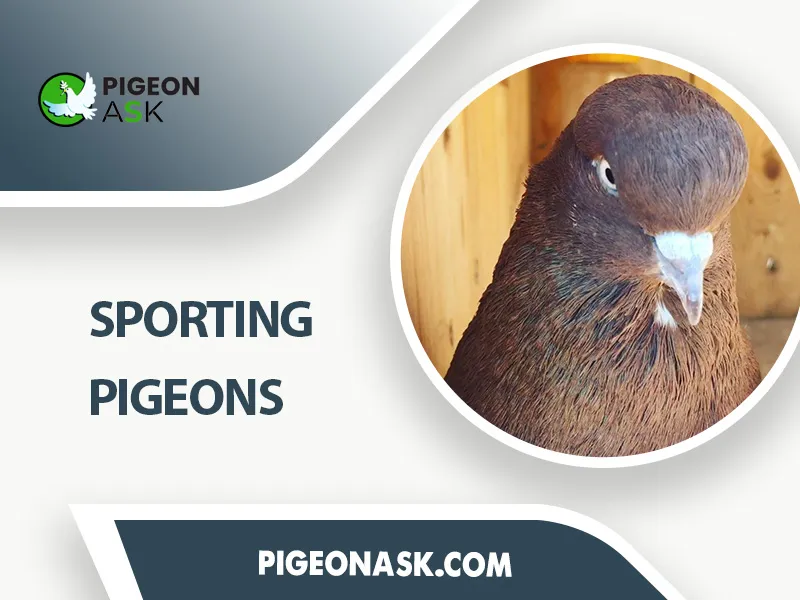
Mainly, owners use these groups of birds in competitions and shows. The breeds of this group are as follows.
#Roller
You can identify this breed with their ruffled, soft and thick feathering. They have excellent skills in rolling.
#Trippler
This breed is mostly popular for its endurance. They can fly continuously for almost 22 hours.
#Iranian High Flyers
Though they have slow wing beats. Yet, they can reach high altitude quickly. Pigeons of this breed can fly for 8-12 hours continuously.
06. Homing pigeons
This breed indicates those pigeons that can come to their home. Fanciers mainly use these types of breeds in various racing shows.

Though they are found all around the world now, they are native to Europe, North Africa and southwestern Asia. A few common examples are:
#Dragon
They are a very alert species and come back home after a long race. This breed has a broad chest and no gullet.
#German Beauty Homer
Their head size is semi-circular and they have a long neck. Fanciers mostly cultivate them for their excellent flying skills. They also use this breed for exhibitions.
The following table exhibits the places of origin and distinguishing features of fancy pigeons.
| Pigeon Breeds | Place of Origin | Year | Unique Features |
|---|---|---|---|
| Voice pigeons | Asia | Unknown | They produce different voices depending on the situation. |
| Cropper | Europe | 16th Century | They have large, inflatable crops.. |
| Frills | Europe and Northern America | 19th Century | They have frills of feathers on their breast or back. |
| Color Family | Various countries, Majorly in Germany | Unknown | They have colorful bodies with distinctive patterns and markings. |
| Sporting Pigeons | Canada, the United States, Asia, Australia, Europe and Africa | Ancient times | They are clever and able to fly fast and perform aerial acrobatics. Also, they are used for people’s amusement. |
| Homing pigeons | Europe, North Africa and Southwestern Asia, Majorly in Belgium and England | 19th Century | They can come to their home by detecting the earth’s magnetic field. |
How Do You Select the Right Variety of Fancy Pigeon Breeds for Your Habitat?
Here’s a step-by-step guide to help you make informed decisions on the selection of the right variety of breeds for your habitats –
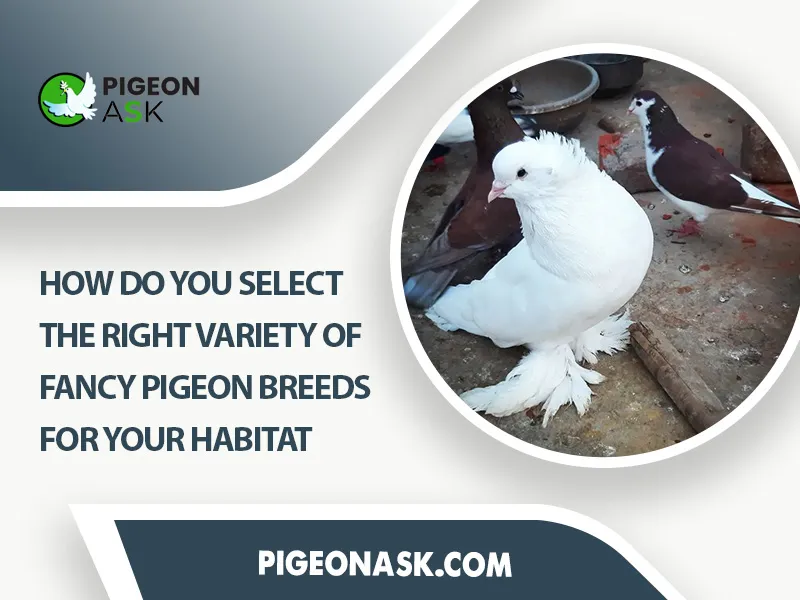
1. Purpose of Keeping Pigeons
If you want to participate in any fancy pigeon competition, you should choose homing or sporting varieties. Otherwise, any color, frills, or voice pigeons are preferable.
Space requirements: Insufficient flying space can lead Flying or sporting groups of fancy pigeons to lose flying skills. Thus, evaluate your habitat, considering factors such as available space and the breeds.
2. Climate Compatibility
Some breeds of fancy pigeons are better adapted to particular climates. Make sure your one gets to adapt to your environment.
Source of the pigeon: When you are buying squabs for cross-breeding, buy from trusted sources. Sometimes, selective breeding can lead to defects like weak eyesight, reproduction barriers, etc.
Hence, try to get information about the breed of pigeons’ parents and grandparents. Also, inquire about the pigeons’ health history and any treatment or vaccinations.
3. Ease of Handling
If you are a fancier newbie, you should choose breeds that are easy to handle.
In this case, common tumblers and fantails are excellent choices. Their appearance is quite neat and clean and they become fond of their owners very soon.
4. Compatibility with Other Pigeons
When you plan to keep multiple varieties, consider their compatibility. Some breeds, like Runts, may coexist well. However, you will find Trumpeters and oriented frills showing territorial or aggressive tendencies.
5. Check Local Regulations
Be aware of the restrictions and comply with local regulations regarding pigeon keeping.
According to American rules, you can’t keep your loft open. Instead, you have to make it rodent and sparrow-proof. Besides, you can’t release your fancy pigeon for exercising after 9 am and before 5 pm.
Creating a Diverse Habitat for Fancy Pigeon Breeds
Creating a diverse and suitable habitat for fancy pigeon breeds includes providing a balanced environment. Here are guidelines for creating such a habitat –
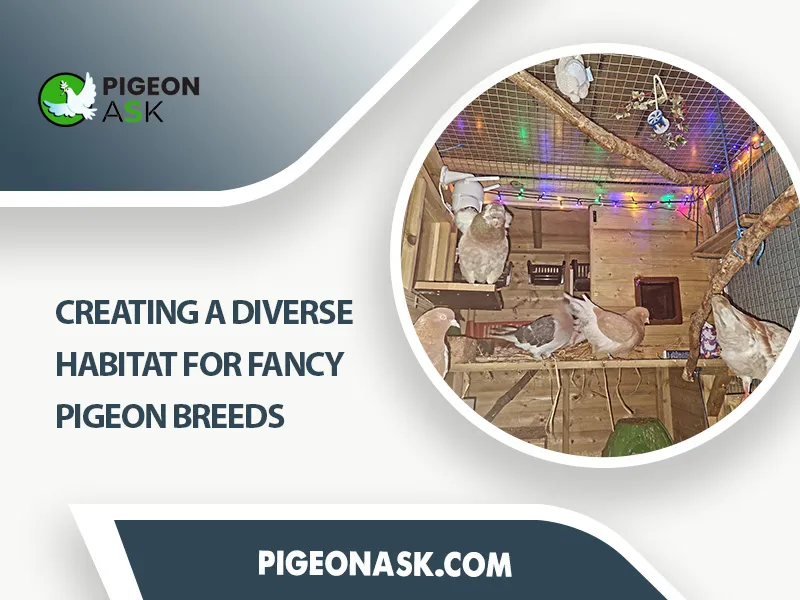
Adequate Space
Generally, the standard size of the wood house for a pair of pigeons can be 24″ L×24″ W×24″ H. But, for smaller species like turbits and tumblers, this dimension can be 12″ L×12″ W×10″ H. Provide only a few holes for their going in and out purposes.
Here is an image of a house for 4 pairs of fancy pigeons.
(image source)
Open Air Flight
Provide a space so they can freely fly there when they want. But, as there is a risk of predation, surround the flight area with chicken wiring.
If you can’t provide outside liberty, add an open space attached to their wood house. Make sure the opening faces the south so that abundant sunlight can reach them.
Nesting Area
Your fancy pigeons will require two nesting sites with proper privacy. Parent pigeons don’t like to stay in their old nesting. That’s why, if you provide two nesting places for each pair, they can nest there alternatively.
Perches and Roosting Spots
Install perches at different heights to accommodate the natural roosting behaviors of pigeons. Varying heights allow them to exercise and relax comfortably.
Feeding Boards
You need to provide feeding boards that have a 1″ edge around the board. This edge helps to prevent scattering of the grains that you serve. Also, provide a water fountain or water dishes for your pigeons.
Feeding And Nutrition Requirements of Fancy Pigeons
Feeding and nutrition are crucial aspects of caring for fancy pigeons to ensure their health and well-being.
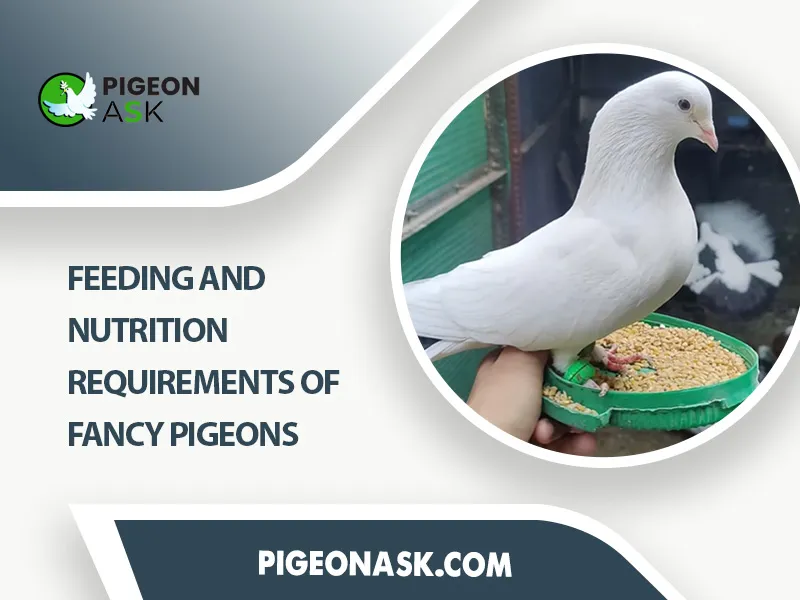
Here are guidelines for you to meet their nutritional requirements –
Nutrition Requirements
Generally, squabs will depend on their parents’ crop milk initially. This will provide them with 11-18% protein and 4.5-12.7% fat.
An adult fancy pigeon will require 12-18% dietary crude protein and 12Mj/kg metabolizable energy.
Typically, their natural diet consists of seeds, grains, fruits, vegetables and water. They also need minerals for the betterment of their bone and egg-laying ability.
Feeding Strategies
Follow these feeding strategies to ensure the proper nutrition of your pet –
- The mix of grain and seeds: Only feeding them seeds may not fulfill their nutritional needs. You better provide them with an ideal mix of wheat, barley, maize, millet, etc.
- Pellets balance: Don’t depend solely on pellets for your pigeons because this may cause them to lose motion. Instead, keep the ratio of pellets and grains 50-50.
- Protein sources: Ensure an adequate protein intake, especially for breeding and growing pigeons. Provide them with protein sources like peas, legumes and small amounts of cooked meat or mealworms.
- Feeder maintenance: You shouldn’t keep the feeding pan exposed to the weather. If sudden rain causes moistening of their feed, clean that immediately. Also, ensure mold, mice, rats, or other birds can’t contaminate your pigeons’ feed.
- Grit and minerals: Buy grit and mineral mixture from commercial stores for your pet pigeons.
- Clean water: Make sure you are keeping the depth of water in the water pan at least ¾”.
- Limiting treats: Limit giving treats to a maximum of 3 times a week. Excessive treats may lead to nutritional imbalances, obesity and other health issues.
- Regular feeding schedule: Keep their feeding schedule consistent. Any abrupt changes in their diet may affect them adversely as they are sensitive to sudden adjustment.
How to Care for Fancy Pigeon Breeds in Different Habitats?
For proper care, you have to understand how the weather of the habitat will affect the pigeon breed. Firstly, let’s know the challenges of keeping fancy pigeons in hot weather.
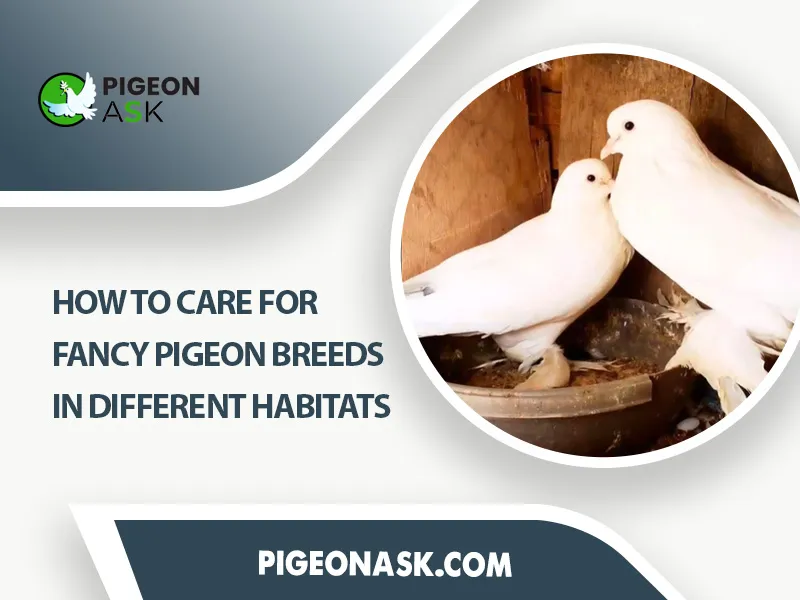
High Body Temperature
Their body temperature exceeds 28°C, so they need to use extra energy to cool down their body. That’s why they are quite susceptible to heat stroke and respiratory issues during summer.
Thus, check the temperature of your pet’s loft daily. If the temperature starts rising, you can set a cooling fan or water mist section to keep the loft region cool.
Dehydration
You need to keep monitoring them to make sure they aren’t getting dehydrated. More than 10% dehydration can be lethal for them.
To monitor if they are getting dehydrated, check their skin elasticity. Pinch a tiny area of your pet’s skin and lift it, then release it.
When the skin takes more than 1 second to return to its position, it indicates dehydration. To prevent this, provide them with enough drinking water and hydrating foods, like fresh fruits and vegetables.
Parasite Attack
Hot weather also comes with the risk of parasite proliferation. So, clean and remove their uneaten foods and fecal matter regularly. You can also provide them with an insecticidal bath.
There are also challenges that you will find as a fancy pigeon owner during cold weather. Most likely, there is a higher risk of frostbiting your pigeons.
Also, if your pigeon pair breeds, younglings will be less likely to survive in cold weather. That’s why they should be kept in their cages and not bred during winter.
Plus, take recommendations from the vet on fancy pigeon care depending on weather conditions. Regular attention and thoughtful adjustments will contribute to the overall well-being of your pigeons in diverse habitats.
How to Care for Fancy Pigeons in Different Climates?
Caring for fancy pigeons in different climates requires adjustments to their environment, diet and health care. Here’s how to do so.

01. Hot Climates
If the climate is hot, provide shade in the loft to protect pigeons from direct sunlight. Also, make sure the ventilation of their cages is adequate to prevent overheating.
Besides, keep shallow containers of water so that they can drink and take baths. You can also provide them with hydrating foods like fruits and vegetables to keep them hydrated.
02. Cold Climates
In cold climate areas, you must clean their lofts more frequently than in hot climate areas. It’s better if you can insulate the loft to retain warmth. As the water gets frozen in winter, you have to clean and refill the water pots daily.
Try to provide warm drinking water to parent pigeons. This will increase the chance of their younglings’ survival as younglings depend on their parents’ crop milk.
Also, in cold climates, pigeons fly less, and their body weight increases compared to their hot climate counterparts. Hence, provide them with less food.
03. Humid Climates
You have to keep their cage clean and dampness-free. Also, keep your fancy pigeons’ feathers dry and moist free. It is because a humid climate poses a higher risk of fungal infections.
Generally, 55%-65% humidity is the appropriate humidity range for your pigeons’ betterment. You may need to use a humidifier or dehumidifier to keep the humidity within this range.
The Benefits of Keeping Fancy Pigeon Breeds in Diverse Habitats
Here are some advantages of keeping fancy pigeon breeds in diverse habitats –
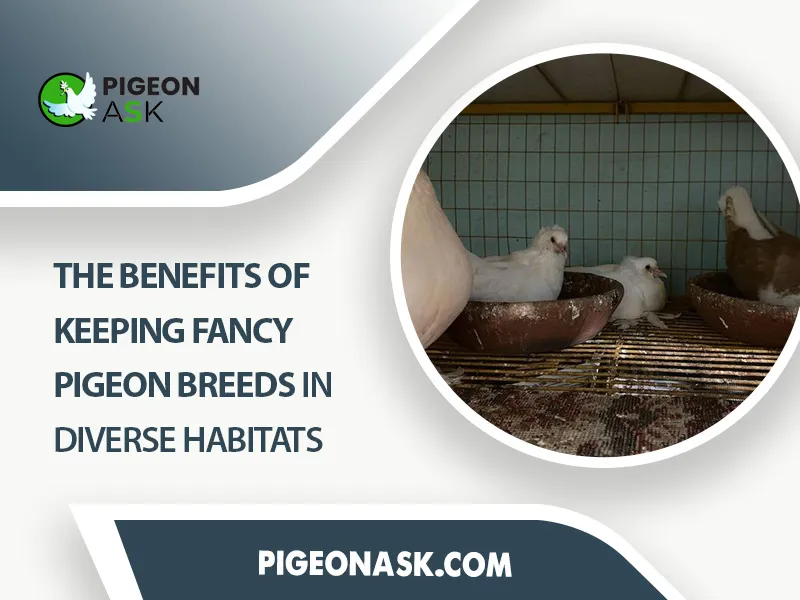
Adaptability
If you expose your pigeons to a diverse environment, their adaptability will also be enhanced. Over time, they will also develop resilience to weather change and surroundings.
Behavioral Enrichment
Diverse habitats will provide them with opportunities for flying and exploration. These will encourage their natural behaviors.
Also, they are involved in Socialization with different flock members. This also results in their well-adjusted behavior.
Genetic Diversity
Exposure to different breeding conditions can contribute to a broader gene pool. Cross-breeding between diverse varieties of fancy pigeons will lead to genetic diversity.
Reduce Monotony
In diverse habitats, your fancy pigeons come in contact with different sights and sound stimulation. These will engage their senses and reduce monotony.
The Benefits of Keeping Fancy Pigeon Breeds in Urban Areas
Keeping fancy pigeon breeds in urban areas can offer several benefits, as mentioned below.
- Caring for fancy pigeons can have therapeutic benefits as a stress reliever for individuals in urban environments.
- Your pigeons can help control insect populations in urban environments.
- Urban pigeon keepers can easily participate in shows and exhibitions, as most of them take place in urban areas.
- In urban areas, the number of natural predators of your pigeon breed will be lower. That’s why you will need to provide them with minimum or no wiring or fencing protection.
- Stray breeds can easily build up their nest in high human-made buildings in urban places.
- You can provide your fancy breeds of pigeons with better care, health and habitat facilities in urban places.
The Impact of Fancy Pigeon Breeds on Local Ecosystems
Here are the potential impacts of fancy pigeon breeds on the local ecosystem –
- Your fancy pigeons may compete with other native bird species for nesting sites or food.
- Different diseases like toxicosis, paratyphoid, pox, cranker, worm infestation, etc., are quite common in these pigeons. They can also introduce most of these diseases to local bird species. (11)
- When you introduce your fancy pigeons to other native pigeon species, it may lead to hybridization. This may integrate the genetics of the native population.
- Falcons are the most common predators of fancy pigeons. Thus, if they can predate the pigeons more, the predator population will also increase.
- Many fanciers kill falcons, crows and other predators to keep their pigeons risk-free. Thus, there is a risk of decreasing the number of the predators.
- They also play a role in seed dispersal. Thus, the local plant population will also increase.
Conclusion
Trumpeters, Fantails, Jacobins, Swallows, Tripplers, Rollers, etc., are fancy pigeon breeds that thrive in diverse habitats.
Though certain breeds may have general adaptability, individual pigeons within those breeds can have unique preferences and sensitivities. That’s why you need to monitor your pets personally to understand them better.
You must provide them with a suitable loft, nutrition, hygiene and appropriate care. With diverse weather and climate conditions, you need to provide them with special care to protect them.
Typically, fancy pigeons are not only for admiration, exhibition, or shows. Their roles in the ecosystem are also undeniable.
References:
- https://www.researchgate.net/publication/369856959_
- https://blogs.bl.uk/asian-and-african/2013/02/pigeon-keeping-a-popular-mughal-pastime.html
- https://www.allaboutbirds.org/news/darwins-other-bird-the-domestic-pigeon/
